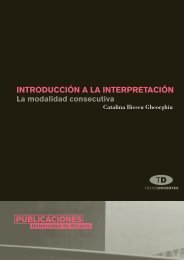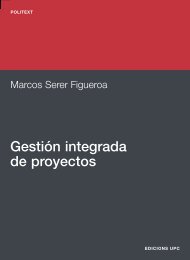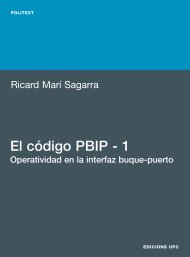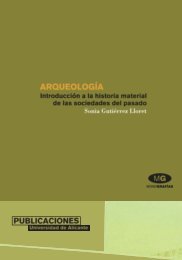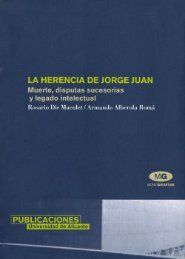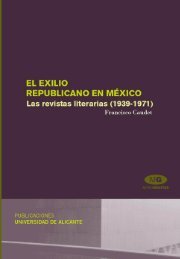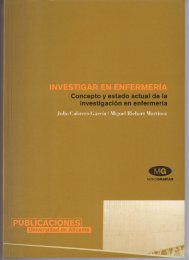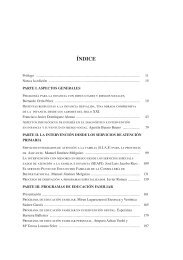Untitled - e-BUC
Untitled - e-BUC
Untitled - e-BUC
You also want an ePaper? Increase the reach of your titles
YUMPU automatically turns print PDFs into web optimized ePapers that Google loves.
8 Índice<br />
II. FUNDAMENTOS TEÓRICOS Y METODOLÓGICOS<br />
3. LA ADQUISICIÓN DE SEGUNDAS LENGUAS . . . . . . . . . . . . 97<br />
3.1. INTRODUCCIÓN A LA ADQUISICIÓN DE SEGUNDAS LENGUAS . . . . 97<br />
3.2. PRINCIPALES TIPOS DE ANÁLISIS DE DATOS: ANÁLISIS CONTRASTI-<br />
VO, ANÁLISIS DE ERRORES, ANÁLISIS DE LA ACTUACIÓN Y ANÁLISIS<br />
DEL DISCURSO . . . . . . . . . . . . . . . . . . . . . . . . . . . . . . . . . . . . . 101<br />
3.3. APORTACIONES DE LOS ESTUDIOS SOBRE INTERLENGUA . . . . . . . 109<br />
3.4. PRINCIPALES MODELOS TEÓRICOS SOBRE LA ADQUISICIÓN DE SE-<br />
GUNDAS LENGUAS . . . . . . . . . . . . . . . . . . . . . . . . . . . . . . . . . . 111<br />
3.5. VARIABLES INDIVIDUALES QUE INFLUYEN EN LOS RESULTADOS DE<br />
LOS APRENDICES . . . . . . . . . . . . . . . . . . . . . . . . . . . . . . . . . . . 121<br />
3.6. LA INFLUENCIA DEL ENTORNO LINGÜÍSTICO Y DEL CONTEXTO ES-<br />
COLAR EN LA ADQUISICIÓN DE SEGUNDAS LENGUAS . . . . . . . . . 125<br />
4. METODOLOGÍA EN LA ENSEÑANZA DE SEGUNDAS LEN-<br />
GUAS . . . . . . . . . . . . . . . . . . . . . . . . . . . . . . . . . . . . . . . . . . . . . . 131<br />
4.1. INTRODUCCIÓN . . . . . . . . . . . . . . . . . . . . . . . . . . . . . . . . . . . . 131<br />
4.2. EVOLUCIÓN HISTÓRICA Y ANÁLISIS CRÍTICO DE LOS PRINCIPALES<br />
MÉTODOS . . . . . . . . . . . . . . . . . . . . . . . . . . . . . . . . . . . . . . . . 135<br />
4.2.1. Métodos anteriores al siglo XX . . . . . . . . . . . . . . . . . . 136<br />
a) Los comienzos de la enseñanza de segundas lenguas:<br />
la tradición dialógica y el método gramáticatraducción<br />
. . . . . . . . . . . . . . . . . . . . . . . . . . . . . . . 136<br />
b) El método directo . . . . . . . . . . . . . . . . . . . . . . . . . 139<br />
4.2.2. Métodos de corte estructuralista . . . . . . . . . . . . . . . . 141<br />
a) El enfoque oral o método situacional de la lengua . . 141<br />
b) El método audiolingual . . . . . . . . . . . . . . . . . . . . . 143<br />
4.2.3. El enfoque cognitivo . . . . . . . . . . . . . . . . . . . . . . . . . . 146<br />
4.2.4. Métodos humanistas . . . . . . . . . . . . . . . . . . . . . . . . . . 147<br />
a) El método silencioso de Gattegno . . . . . . . . . . . . . 148<br />
b) La sugestopedia de Lozanov . . . . . . . . . . . . . . . . . 149<br />
c) El aprendizaje de la lengua en comunidad de Curran 150<br />
d) El método de respuesta física total de Asher . . . . . 152<br />
e) El método natural de Krashen y Terrell . . . . . . . . . 153<br />
4.2.5. Métodos de orientación comunicativa . . . . . . . . . . . . 155<br />
a) El proyecto de Nivel Umbral . . . . . . . . . . . . . . . . . 157<br />
b) El enfoque comunicativo . . . . . . . . . . . . . . . . . . . . 158<br />
c) El enfoque por tareas . . . . . . . . . . . . . . . . . . . . . . . 161



